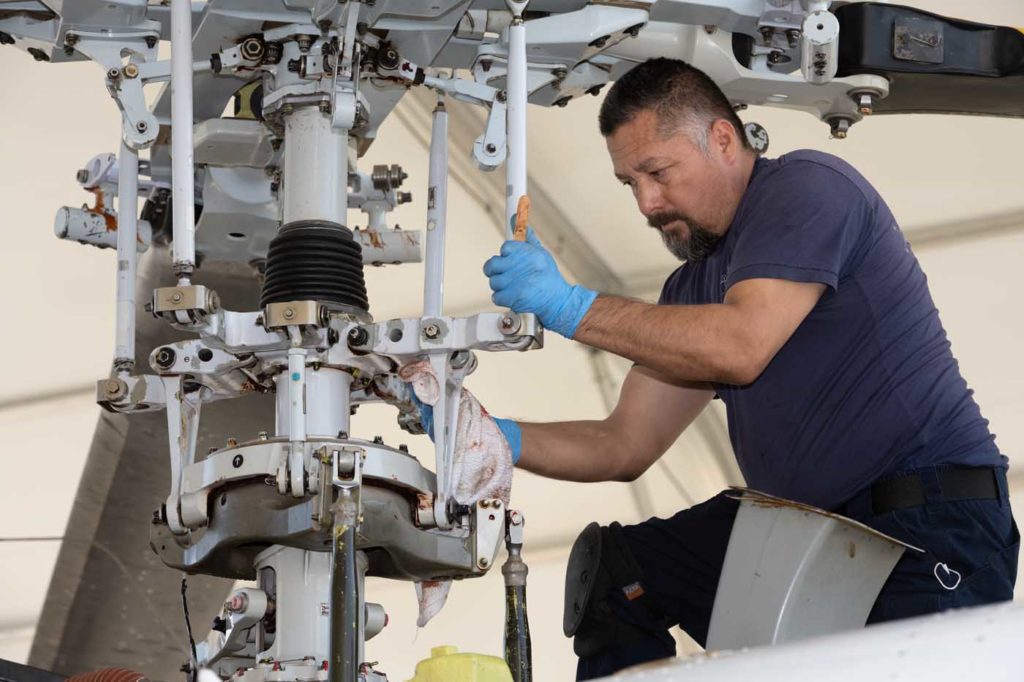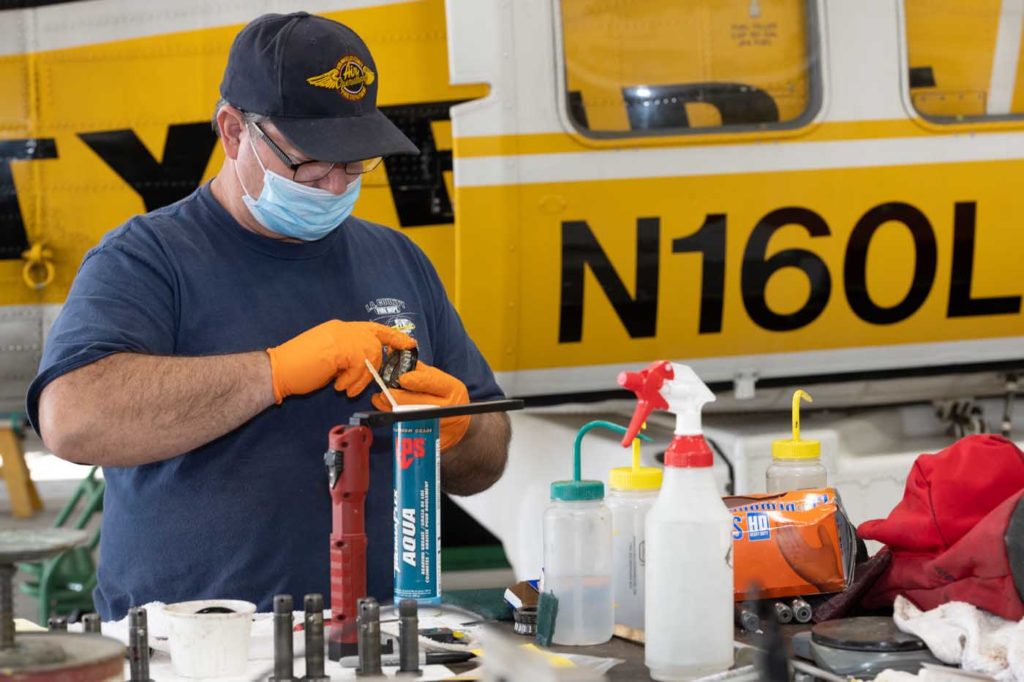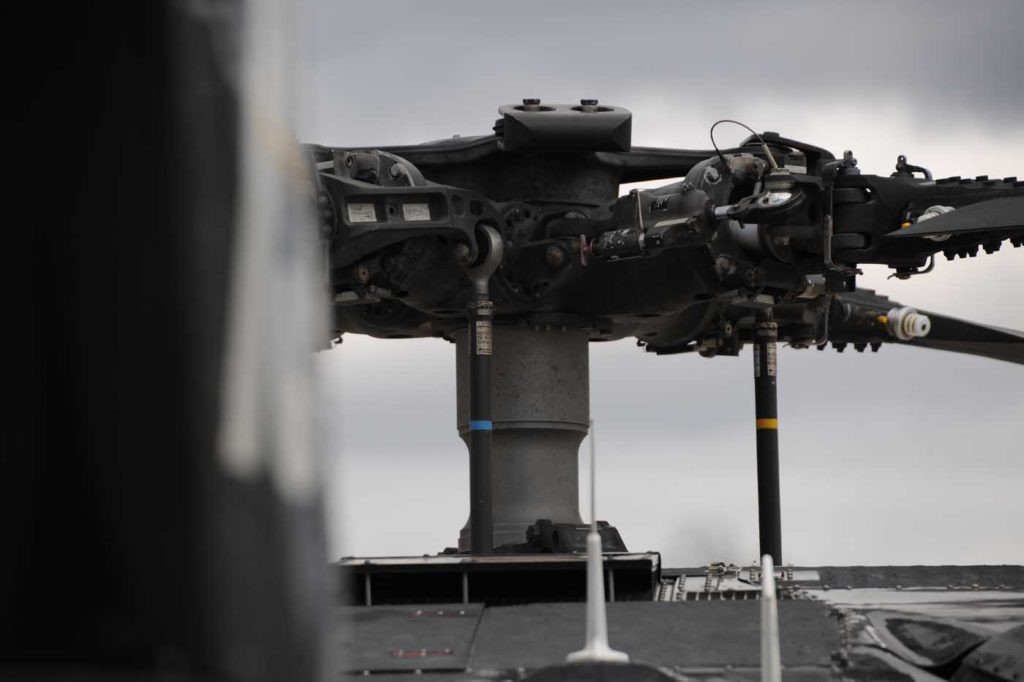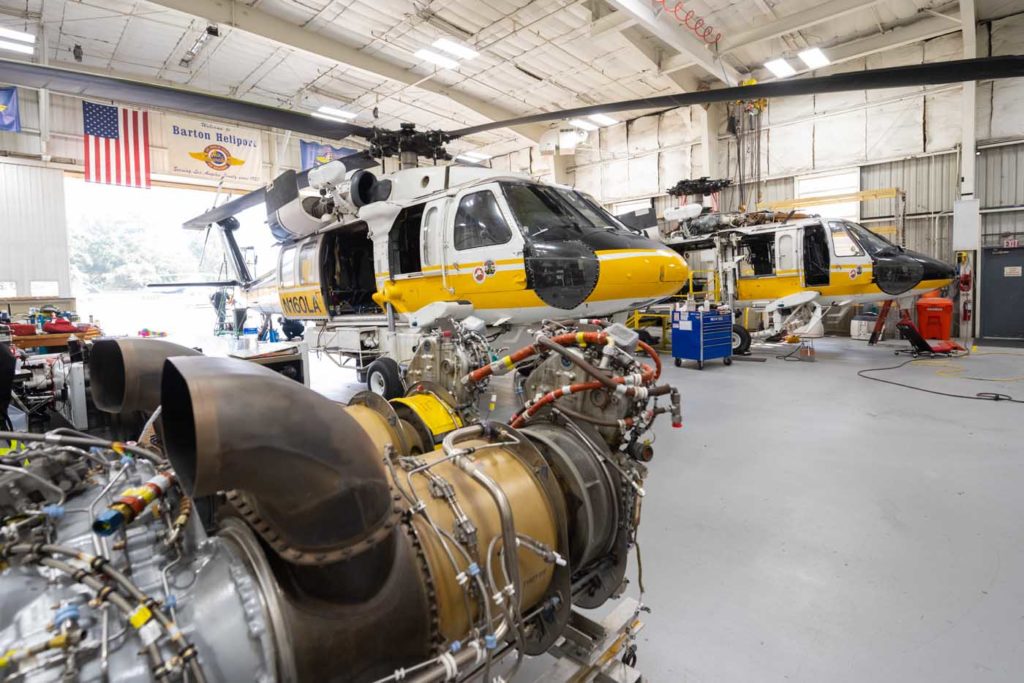
The Los Angeles County Fire Department Air Operations Section responds to everything from wildfires to offshore and mountain rescues, and is in the process of updating its fleet to do it all even better.
It has proven to be another busy year for Los Angeles County Fire Department’s (LACoFD’s) aviation unit. But as the frequency of enormous wildfires in the region has increased, so has the unit’s capability to attack them. Today, when a wildfire is reported anywhere in the county, the unit can launch four helicopters to attack it at a moment’s notice. But the unit’s responsibility isn’t limited to fighting the county’s record-breaking blazes; on any given shift, it could be called to a medical emergency miles off the California coast on Catalina Island, or be asked to find and hoist aboard a lost or injured hiker in high mountains.
As they say, it’s all in a day’s work.
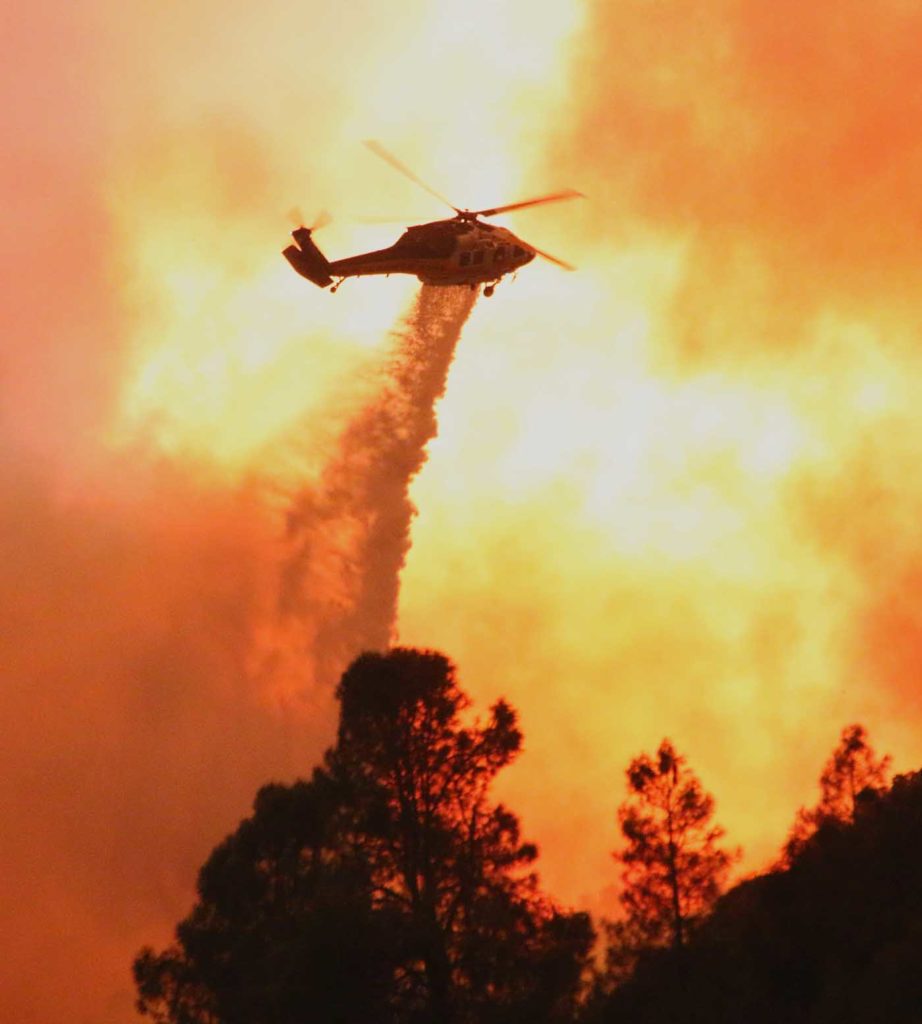
The LACoFD Air Operations Section (AOS) has long enjoyed a reputation as a premier firefighting and public safety operator. The unit provides round-the-clock emergency coverage to over 10 million residents across 4,100 square miles (10,600 square kilometers), including 70 miles (112 kilometers) of Pacific shoreline, two offshore islands, vast inland deserts and rugged coastal mountains that rise to more than 10,000 feet (3,050 meters).
Based at Barton Heliport at Whiteman Airport, 20 miles (32 kilometers) north of downtown Los Angeles, LACoFD AOS is staffed by 12 helicopter pilots flying day and night under visual flight rules and with night vision goggles (NVGs). Eighteen firefighter/paramedics teamed in two-person squads serve as crew chief and rescue specialists. These three-person crews make up AOS’s “regional air squads.”
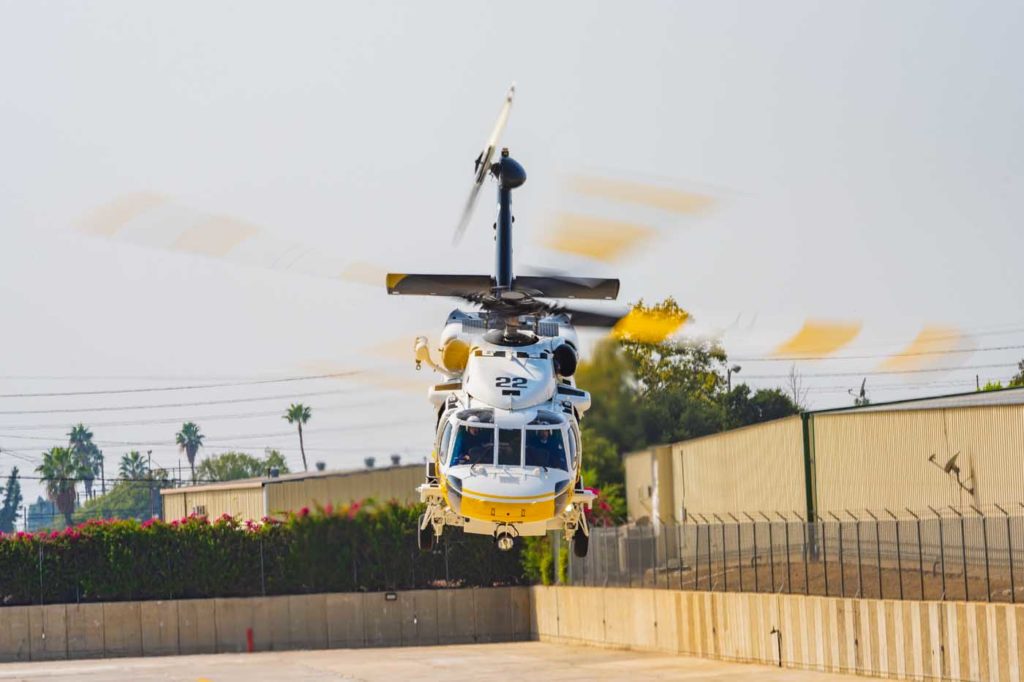
Each morning, a minimum of three regional air squads launch from the Barton Heliport, typically before 10 a.m., repositioning to remote operations bases throughout the county.
Crews work 24-hour shifts, performing missions that range from hoist rescue and blue-water response to search-and-rescue (SAR) and firefighting. They return to Barton the following morning for crew change and daily aircraft maintenance.
During periods of high fire danger, staffing may be increased to field five aircraft. These may include aircraft dedicated strictly to firefighting, and a helicopter coordinator (HLCO) to manage air traffic over congested scenes. During periods where LACoFD aircraft are committed to firefighting, a sixth aircraft may be brought online to ensure adequate air medical coverage.

“We’re primarily what we call a QRF, or a quick reaction force, which is designed for a quick response to get there and get into the fight,” said Eric Pacheco, a senior pilot. “We just can’t sustain that for long periods of time. We can get in there and sustain a high-level fight for a short period of time. But if it goes to a longer or a campaign fire, we start to dwindle our resources pretty quick. So we’re looking for the cavalry to come in and take over so we can regroup for any other starts that may occur.”
“Those aircraft are there to support the ground unit,” said senior pilot Mike Sagely. “Our goal is to provide the best fire suppression support to the guys on the ground and the leadership that’s making the decisions on whatever the strategies are on the operation. And we do that by being very aggressive, getting to the fire very quickly. I think we pride ourselves on being tactically sound with those first 10 or 15 minutes, meaning you drop water where it makes sense to anchor the fire and buy some time and be as productive as possible.”

The fleet
In 2019, the LACoFD fleet of five Bell 412s (three 412EPs and two 412HPs) and three Sikorsky S-70A Firehawk helicopters turned roughly 2,900 hours, conducting 1,174 total public safety missions, 647 EMS responses, 466 medical transports, 134 hoist rescues, and 369 fire responses that delivered over 1.5 million gallons (5.7 million liters) of water and fire suppression foam.
L.A. County was the first public safety operator of the Firehawk, initially acquiring two in 2001 and a third in 2005.
“We have had the Firehawk in service for the County of Los Angeles Fire Department for 20-plus years. [The Firehawk] has performed flawlessly,” said Pacheco. “This has been proven with performance, dependability, safety and reliability. Sikorsky/Lockheed has taken an already capable product line and stepped up the game on improvements with blending technology to enhance an already proven product line.”
In August 2020, two additional S-70i Firehawks entered service, greatly enhancing capabilities and overall mission readiness.
“The proven effectiveness of the S-70 Firehawk as the perfect platform to perform our multi-mission responsibilities has been [shown] over the past 20 years, there’s no doubt about that,” said Air Operations Battalion Chief Pat Sprengel. “The new aircraft will allow L.A. County to operate at a high level of effectiveness during the fire season with at least three Firehawks available daily. This ensures the aircraft will be more efficiently staffed and available during critical times.”
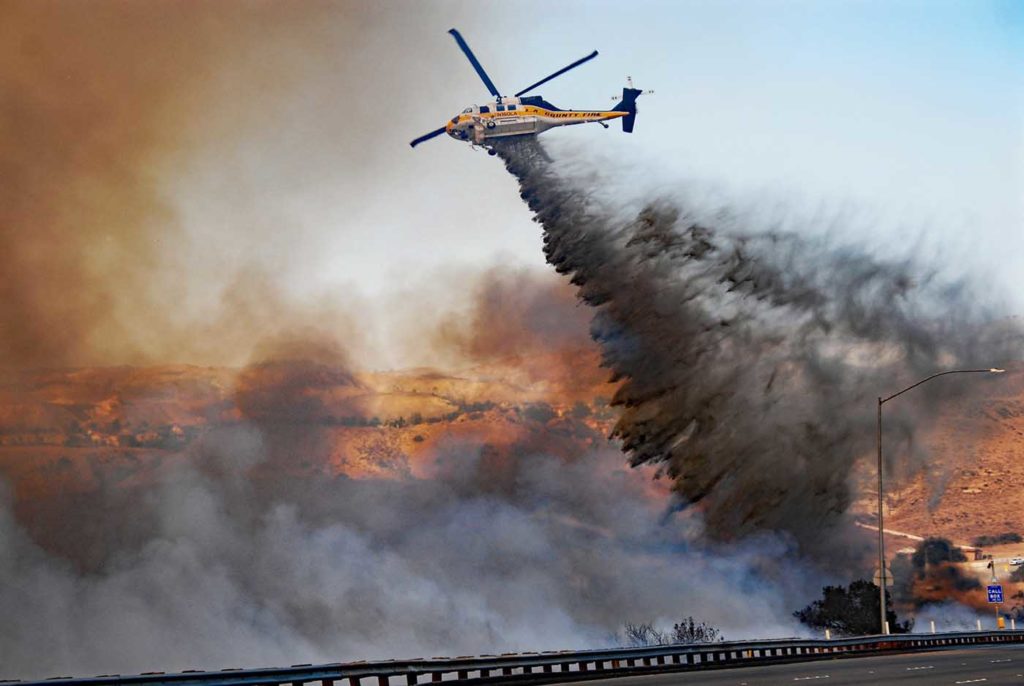
The 412s are still used as multi-mission aircraft, Sprengel said. They perform water drops admirably, but cannot carry as much water as the Firehawks.
“They’re still the backbone of our EMS mission,” Sprengel said. “They’re excellent for transports to the hospitals and specialty centers. And they’re also very capable aircraft for SAR and hoist rescue.”
For the fire mission, the 412s have 360-US gallon (1,360-liter) belly tanks and a standard external snorkel. Firehawks are equipped with a 1,000-US gallon (3,785-liter) belly tank/30-US gallon (113-liter) foam-injection tank, a retractable snorkel and high-efficiency water pump providing a fill time of 45 seconds. They can also accept a rear cabin seating configuration for transporting up to 11 firefighters. All Firehawks have a night vision-compatible cockpit and rear cabin lighting and Spectrolab SX16 Nightsun searchlights.
Both airframes are configured similarly for the air medical and SAR mission and can be quickly reconfigured.
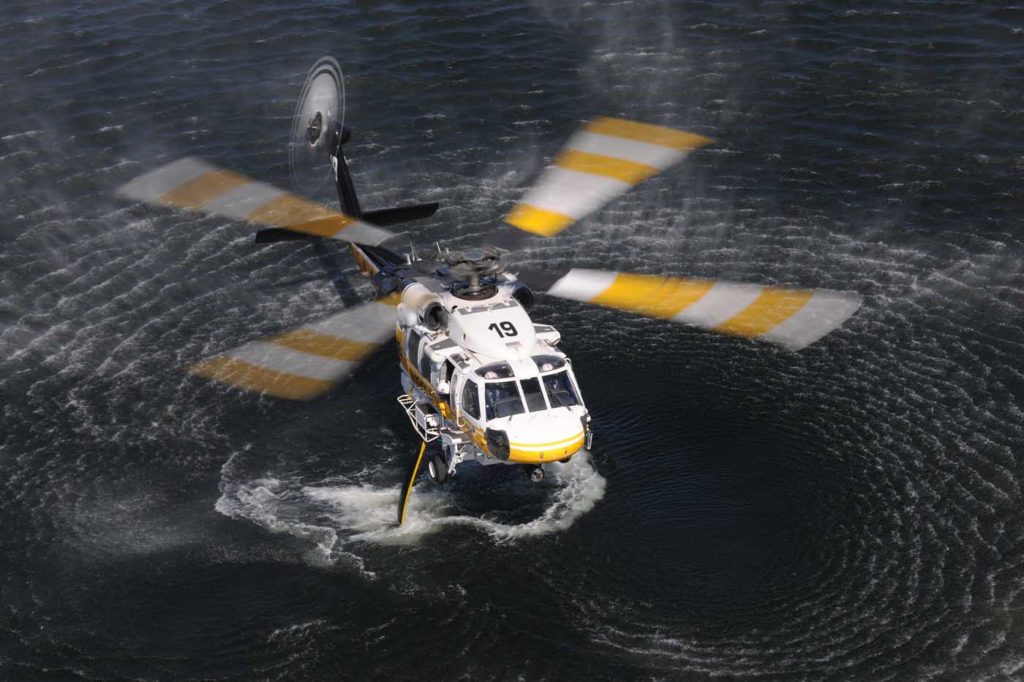
“We try to be airborne within five minutes of the time of the call,” said firefighter/paramedic Michael Nelson. “And we’ve learned over the years that it’s best to keep our equipment with us. So, all of our aircraft have the full ALS [advanced life support] complement of equipment and we will take it with us to a fire. Then, if need be, we will off-load equipment at one of our heli-spots. So we can switch between mission configurations in less than five minutes to respond to whatever we need to do.”
Maintaining readiness
LACoFD maintenance technicians are responsible for maintaining the fleet and ensuring the necessary level of readiness.
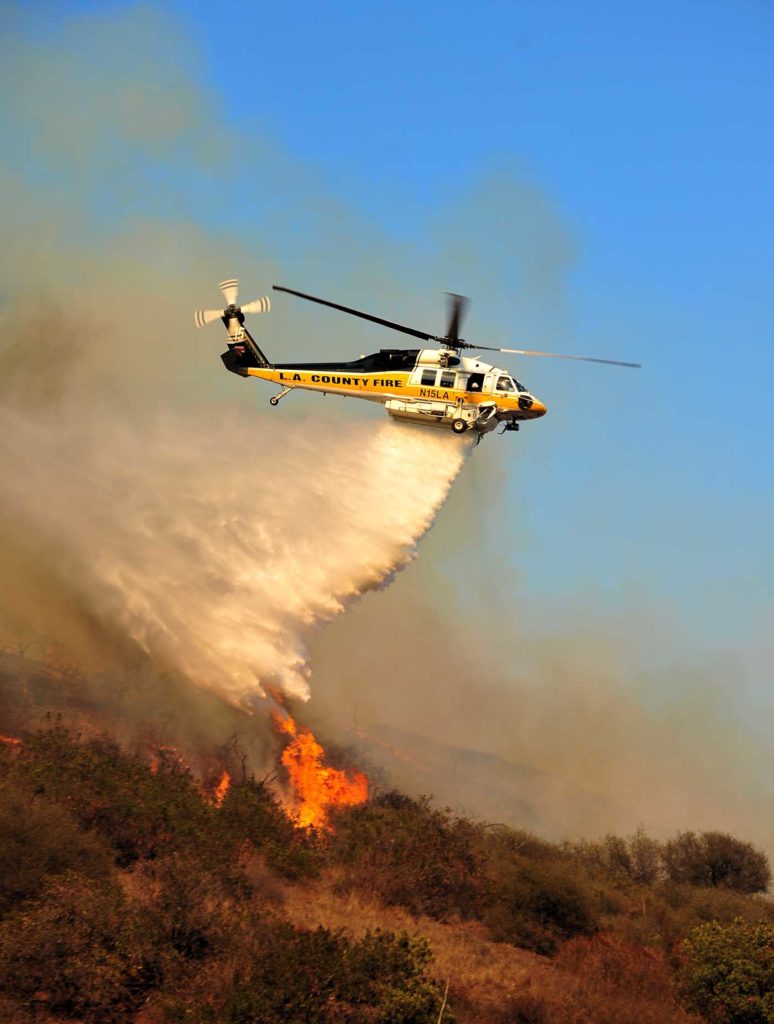
“What’s really unique about this place is everything from day-to-day maintenance to some depot-level stuff is done here,” said LACoFD chief of helicopter maintenance Dennis Blumenthal. “We do all of the installs, we do all the composites and sheet metal and modifications. . . . Anything that gets done to these helicopters that can be done here, including overhauls and heavy maintenance, we’ll do right here.”
The county mandates LACoFD to have a minimum of three helicopters available every day, around the clock. With a fleet of 10 aircraft, that could seem like a pretty low bar. But that isn’t the case. In recent years, Blumenthal has had to juggle his scheduled maintenance due to the year-round fire season.
“I [used to] schedule maintenance so that most of the heavy stuff was done January through May,” Blumenthal said. “In the past five or eight years, we’ve had all these huge fires in January through May as well. So now, with 10 aircraft, I can no longer even plan on January through May. Major scheduled maintenance on both airframes has become much more intense. The PMIs [phase maintenance inspections], the 360s [flight hour inspections] and the 720s, on [Firehawk] legacy ships, it could be anywhere from six to 12 weeks.”
-

An unusually early and busy 2020 fire season taxed maintenance crews charged with maintaining the readiness of the fleet. Photos by Dan Megna and Greg Doyle
An unusually early and busy 2020 fire season taxed maintenance crews charged with maintaining the readiness of the fleet. Photos by Dan Megna and Greg Doyle
He added that the newer ships have less problems and parts are more readily available, so they’re generally quicker through their service. “Bell has implemented a 600-hour airframe inspection every year,” he said. “So now, instead of having an annual that took a week or a week-and-a-half, we’re now looking at sometimes four weeks to get these things completed.”
Blumenthal has been somewhat frustrated by the difficulty of finding qualified maintenance technicians who possess a genuine passion for doing the work. Presently, they are operating with only nine of the allotted 14 technicians. As a result, overtime is required to meet his maintenance needs. In August, his crew — including two inspectors and three senior mechanics — worked 995 hours of overtime, he said.

To augment staffing, Blumenthal has contracts with two outside providers. Rotorcraft Support Inc. and Helicopter Support Inc. provide additional component work and manpower during the busy periods, such as fire season.
While the workload may often be hefty, Blumenthal believes his technicians possess a sense of genuine pride in how their work improves public safety.
“They know every one of these helicopters takes off for one reason and only one reason: to save lives or property,” Blumenthal said. “There are no ‘non-essential’ flights. It’s amazing, when we turn on CNN or local news and you see your helicopters, there’s just a complete sense of pride that the individuals here get, because they know those crews are doing their jobs because of the jobs that we’re doing. None of us ever got that feeling working anywhere else.”
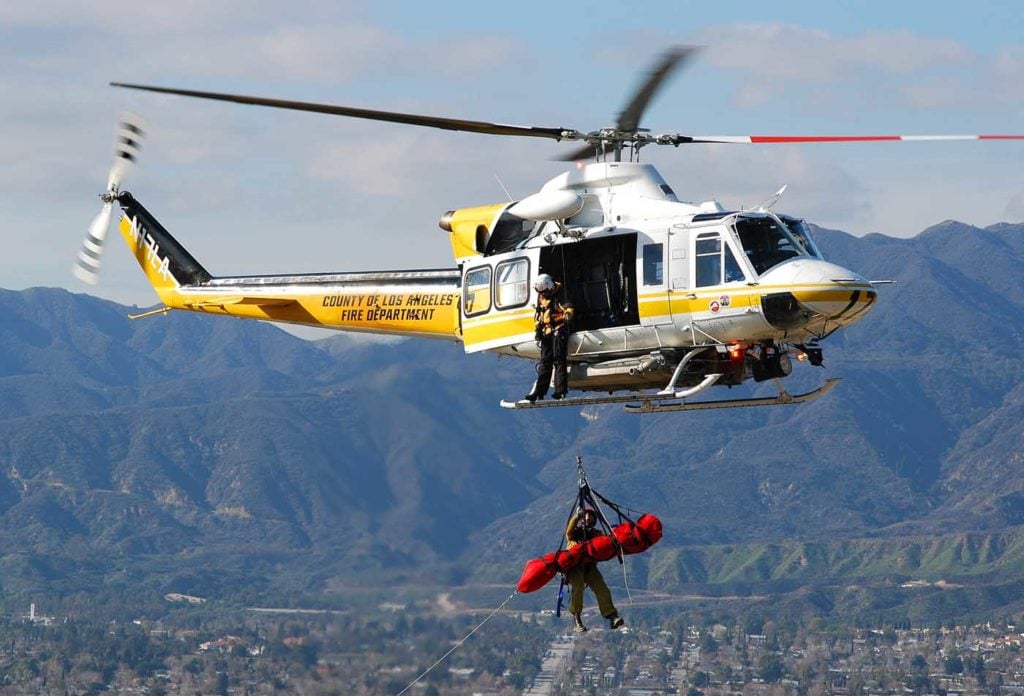
All day, every day
In L.A. County, the two new S-70i Firehawks are key elements in the fire department’s aggressive initial attack strategy.
“Because of the urban interface with building up to the edge of the wildland, our push in L.A. County is to send an extremely robust response of aircraft to keep the fire small,” Sprengel said. “So, if we had a first alarm right now we would typically send four helicopters and two [contract] CL-415” Super Scoopers.
In addition to providing service throughout Los Angeles County, the department also maintains strong relationships with neighboring agencies, promoting cooperative mutual aid. It’s not uncommon to see LACoFD aircraft supporting initial attack efforts in nearby Ventura or Orange counties, or working overnight on NVGs on a sustained attack for structure protection 100 miles (160 kilometers) away in Santa Barbara County. Of course, when the need arises, these allied agencies will send their assets to support urgent missions in L.A. County, as well.
With three LACoFD Firehawks in service with the agency for 20 years and the 412 fleet also aging, there is an effort underway to modernize the fleet, Sprengel said.
“Our mission moving forward is replacement of both the three older Firehawks as well as the 412 fleet, which is also getting older,” Sprengel said. “It’s nice having a multi-aircraft fleet because of the diversity it gives us and the 412 is a very capable aircraft. It just doesn’t give us the 1,000-gallon load that the Firehawk spoils us with.”
LACoFD’s reputation as a premier firefighting and public safety operator/agency is due in part to the highly dynamic environment in which its crews work. While the diversity of the mission and high call volume is indeed unique, some in the organization point to the character of the individuals that make up the AOS as the key to overall success. “It’s that esprit de corps, that warrior ethos, the mentality, the equipment,” said Sagely, ruminating on lessons learned from 17 years as an Army special operations pilot.

“You go and throw it all into an egg beater and you end up with this really unique model of people. They’re like-minded in their mentality, their work ethic, their approach towards their responsibilities to their mission, their responsibility to the taxpayers, and that’s not just the pilots — that’s the crew chiefs, crewmembers and maintenance crew as well. But collectively, as a section, we get on it. And we do it every day and we do it every time we go out.”


